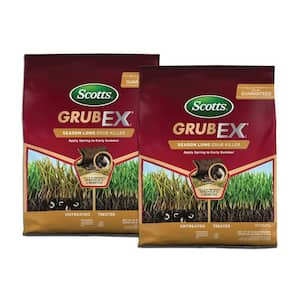

Doing this will create a grid around four square feet in size.
#Lowes milky spore how to#
The simplest way, how to apply milky spore powder is to place a teaspoon of milky spore around your lawn about four feet apart from each other. However, it is best to follow these simple guidelines on how to do it for the best effect. It is very easy how to apply milky spore to your lawn garden. If, for any reason, you are unable to apply at this time, you can use it in the summer. At this time, the beetle grub will be busy feeding to increase their weight for the winter.īesides this, the soil is still warm. The best time to apply this pest management compound is during the early fall. In the granules, you apply this twice per year for two or three years, where it will be effective for up to 20 years. If you use the spore powder, you will apply this to your lawn once or twice. Neither being difficult yet one is a little easier than the other. The difference is the application of each. There isn’t much difference between Milk Spore powder and granular Milky spore. (Find the Best Grub Worm Killer) What is the Difference Between Milky Spore Granules and Milky Spore Powder? This completely natural and organic lawn care treatment does not destroy trees, shrubs, or any insects beneficial to your garden, or adversely affecting water supplies, including wells, ponds, or rivers. They claim it is not harmful to humans, animals, and birds. USDA has cleared the product for use on beetle larvae. The spores become active in warm, moist soil and can take up to three years to take effect. The milk spore is a naturally growing bacteria, with the active ingredient being Bacillus popilliae. Milky spores have been in production since the 1940s specifically for pest control against the Japanese beetle grub, which is the only known organism to be vulnerable to the Milky Spore disease. Here you can learn more about milky spore, how to use it for long-term lawn and garden care. While adult beetles are difficult to kill, their larvae are vulnerable to several different biological treatments, most notably milky spore disease. To make it worse, the Japanese beetle larvae love to feed on the grass roots, leaving ugly dead brown spots on your lawn. Japanese beetle grubs can cause severe damage to your lawn in a short span of time. Stainless Steel Micro Mesh Gutter Guards.Briggs And Stratton Snow Blower Reviews.Riding Lawn Mower With Snow Blower Attachment.Once the powder is watered in, you can safely mow or walk on the lawn. Water it in with a gentle spray from a hose for about 15 minutes. Place a teaspoon (5 ml.) of milky spore powder on the lawn, spacing the applications about 4 feet (1 m.) apart to form a grid. Knowing how to apply milky spore is important for effective control. Although the grubs are in the soil year-round, it only works when they are actively feeding. The best time of year to use the product is fall, when the grubs are feeding aggressively. Ideal soil temperatures for using milky spore are between 60 and 70 degrees F. You can also use milky spore in vegetable gardens without fear of crop damage or contamination. When using milky spore for lawns, it can take three years to achieve control of the insect in warm climates, and even longer in cooler areas.

The bacteria remain in the soil for two to ten years. Japanese beetle larvae are the only organisms known to be susceptible to the disease, and as long as they are present in the soil, the bacterium increases in numbers. After the larvae eat the bacteria, their body fluids turn milky and they die, releasing more of the bacterial spores into the soil. Although it isn’t new, it is still considered one of the best methods of control for Japanese beetles. Long before horticulturalists coined the terms “integrated pest management” and “biological controls,” the bacterium Paenibacillus papillae, commonly called milky spore, was commercially available to control Japanese beetle larvae, or grub worms. Let’s learn more about using milky spore for lawns and gardens to control these grubs. The adult beetles are tough and difficult to kill, but their larvae are susceptible to several biological controls, including milky spore disease. To add insult to injury, their larvae feed on grass roots, leaving ugly and brown dead spots in the lawn.

Japanese beetles can strip the foliage from your prized plants in no time.


 0 kommentar(er)
0 kommentar(er)
